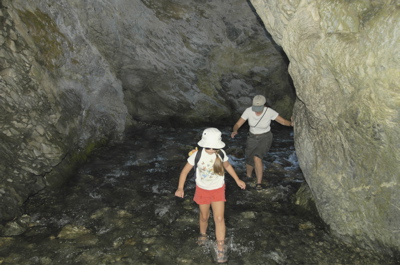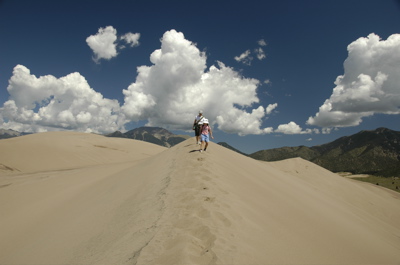Coming to high altitude areas and hiking requires some acclimation. Normally we are above 5000 feet for at least a few weeks before we attempt hiking in the mountains, but this time it didn’t work out that way. So when we started climbing up giant sand dunes in the morning, it was more of a challenge than you’d think.
The dunes are mammoth, with the big ones running 600-750 feet tall. The big ones are surrounded by foothills of sand, so at first the climbing doesn’t seem that bad. But being made of shifting sand, there is no trail, and it’s easy to summit a sandy peak only to find that a massive canyon lies between you and the next dune.  After about 90 minutes of zig-zagging across the steep slopes, we finally reached the top of one of the higher dunes, and stopped for a snack, some oxygen, and a quiet look at the gorgeous view.
After about 90 minutes of zig-zagging across the steep slopes, we finally reached the top of one of the higher dunes, and stopped for a snack, some oxygen, and a quiet look at the gorgeous view.
Hiking in the dunes can be extremely arduous and even dangerous under some conditions. Summer temperatures on the dunes can reach 140 degrees, and thunderstorms are common. If you’re on the dunes during lightning, you may have a bad day ““ and it’s hard to escape quickly. For these reasons we went out in the morning, and were lucky enough to enjoy absolutely spectacular weather and crystal visibility.
 Water and sunscreen are the other keys. It’s like being on a sunny beach, only with no shoreline. Bring a lot of water on a warm day. Don’t be fooled by the green pines that cover the mountains. The dunes are a desert environment. I filled my 100-oz Camelbak and the three of us drained it in about three hours, plus some additional 16-oz bottles. The problem with the sunscreen is that the sand sticks to it, but there’s no point in worrying about that. You’ll come out of the dunes with sand in every possible location anyway.
Water and sunscreen are the other keys. It’s like being on a sunny beach, only with no shoreline. Bring a lot of water on a warm day. Don’t be fooled by the green pines that cover the mountains. The dunes are a desert environment. I filled my 100-oz Camelbak and the three of us drained it in about three hours, plus some additional 16-oz bottles. The problem with the sunscreen is that the sand sticks to it, but there’s no point in worrying about that. You’ll come out of the dunes with sand in every possible location anyway.
While it hasn’t been extremely hot, we took the middle of the day off from hiking and stretched out in the Airstream. Like other western parks, there are higher altitude spots to go when the heat is oppressive. In the afternoon we chose Zapata Falls (just outside the park entrance). To get there, you drive up a winding rocky road to a trailhead at about 9000 ft, then hike up further on a half mile trail to a refreshing mountain creek in the trees.
 This is where it gets interesting. Zapata Falls are inside a very narrow gorge, and the only way to see the falls is to hike upstream a short distance through icy cold water. The creek narrows to a slot in the rock, and after passing through that you can glimpse the water falling. Since you do this while standing in calf-deep water that makes your feet go numb, the visit is brief. But it’s worth the trip. The hike also offers some nice views of the Dunes from above.
This is where it gets interesting. Zapata Falls are inside a very narrow gorge, and the only way to see the falls is to hike upstream a short distance through icy cold water. The creek narrows to a slot in the rock, and after passing through that you can glimpse the water falling. Since you do this while standing in calf-deep water that makes your feet go numb, the visit is brief. But it’s worth the trip. The hike also offers some nice views of the Dunes from above.
As a wind-down, we drove down the Medano Primitive Road in the park to get a different perspective on the dunes. Ordinary cars can traverse the first mile of the road, but then it becomes 4WD only. If you want a long 4WD adventure, you can go 12 miles all the way up to a mountain pass above 9000 ft and then hike another 1900 feet of elevation to a lake. That’s one I’d like to try.
The hiking here has been great, and if we had another full day we’d take one of the longer alpine trails up into the Sangre de Cristo Range. Despite the challenge of acclimating to steep hikes about 9000 feet, we all really like this park. I think we will come back.



August 28th, 2008 at 5:20 pm
Sometime, if you are on I-20, west of Odessa/Midland in Texas, stop by Monahans Sand Dunes State Park. The campground is literally sandwiched into the dunes. The dunes aren’t quite as large as those where you are now, but they are quite impressive.
The town of Monahans is reviving with the revival of the oil industry. Not a lot to do there, but I had a great Mexican meal.
August 29th, 2008 at 8:05 pm
Nice pics… and nice hats!
Welcome back to our western sun, galaxy traveler…
Where sunscreen and hats are in order.
More about Sun safety at:
http://airstreamlife.com/historysafariexpress/2008/08/24/sun-safety/